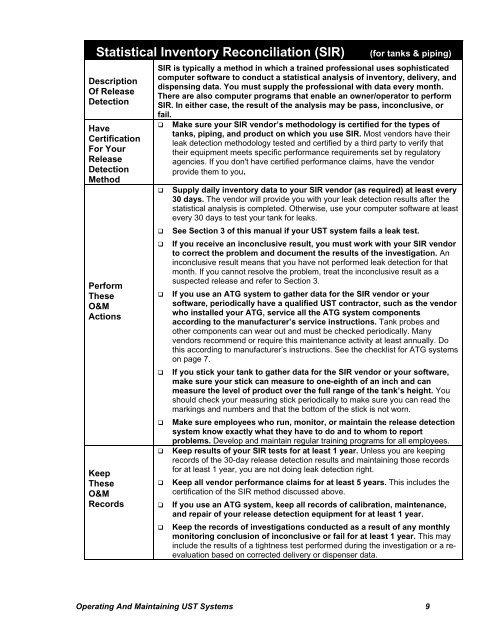Operating And Maintaining Underground Storage Tank Systems ...
Operating And Maintaining Underground Storage Tank Systems ...
Operating And Maintaining Underground Storage Tank Systems ...
You also want an ePaper? Increase the reach of your titles
YUMPU automatically turns print PDFs into web optimized ePapers that Google loves.
Statistical Inventory Reconciliation (SIR)<br />
Description<br />
Of Release<br />
Detection<br />
Have<br />
Certification<br />
For Your<br />
Release<br />
Detection<br />
Method<br />
Perform<br />
These<br />
O&M<br />
Actions<br />
Keep<br />
These<br />
O&M<br />
Records<br />
(for tanks & piping)<br />
SIR is typically a method in which a trained professional uses sophisticated<br />
computer software to conduct a statistical analysis of inventory, delivery, and<br />
dispensing data. You must supply the professional with data every month.<br />
There are also computer programs that enable an owner/operator to perform<br />
SIR. In either case, the result of the analysis may be pass, inconclusive, or<br />
fail.<br />
Make sure your SIR vendor’s methodology is certified for the types of<br />
tanks, piping, and product on which you use SIR. Most vendors have their<br />
leak detection methodology tested and certified by a third party to verify that<br />
their equipment meets specific performance requirements set by regulatory<br />
agencies. If you don't have certified performance claims, have the vendor<br />
provide them to you.<br />
<br />
<br />
<br />
<br />
<br />
<br />
<br />
<br />
<br />
<br />
Supply daily inventory data to your SIR vendor (as required) at least every<br />
30 days. The vendor will provide you with your leak detection results after the<br />
statistical analysis is completed. Otherwise, use your computer software at least<br />
every 30 days to test your tank for leaks.<br />
See Section 3 of this manual if your UST system fails a leak test.<br />
If you receive an inconclusive result, you must work with your SIR vendor<br />
to correct the problem and document the results of the investigation. An<br />
inconclusive result means that you have not performed leak detection for that<br />
month. If you cannot resolve the problem, treat the inconclusive result as a<br />
suspected release and refer to Section 3.<br />
If you use an ATG system to gather data for the SIR vendor or your<br />
software, periodically have a qualified UST contractor, such as the vendor<br />
who installed your ATG, service all the ATG system components<br />
according to the manufacturer’s service instructions. <strong>Tank</strong> probes and<br />
other components can wear out and must be checked periodically. Many<br />
vendors recommend or require this maintenance activity at least annually. Do<br />
this according to manufacturer’s instructions. See the checklist for ATG systems<br />
on page 7.<br />
If you stick your tank to gather data for the SIR vendor or your software,<br />
make sure your stick can measure to one-eighth of an inch and can<br />
measure the level of product over the full range of the tank’s height. You<br />
should check your measuring stick periodically to make sure you can read the<br />
markings and numbers and that the bottom of the stick is not worn.<br />
Make sure employees who run, monitor, or maintain the release detection<br />
system know exactly what they have to do and to whom to report<br />
problems. Develop and maintain regular training programs for all employees.<br />
Keep results of your SIR tests for at least 1 year. Unless you are keeping<br />
records of the 30-day release detection results and maintaining those records<br />
for at least 1 year, you are not doing leak detection right.<br />
Keep all vendor performance claims for at least 5 years. This includes the<br />
certification of the SIR method discussed above.<br />
If you use an ATG system, keep all records of calibration, maintenance,<br />
and repair of your release detection equipment for at least 1 year.<br />
Keep the records of investigations conducted as a result of any monthly<br />
monitoring conclusion of inconclusive or fail for at least 1 year. This may<br />
include the results of a tightness test performed during the investigation or a reevaluation<br />
based on corrected delivery or dispenser data.<br />
<strong>Operating</strong> <strong>And</strong> <strong>Maintaining</strong> UST <strong>Systems</strong> 9















